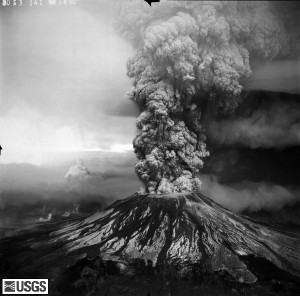16 December 2010
Careful! Sudden increase in stress could cause major eruptions
Posted by mohi
We’ve all had times when a sudden pile of stress makes us ready to explode at any minute. Volcanoes might react the same way–a new hypothesis presented in Wednesday morning’s poster session suggests that rapid changes in the amount of stress on the Earth’s crust might explain a cyclical pattern of volcanic activity over the last million years.

Volcanic eruptions across the world may be synched in cycles, according to a new study of eruptions across the Pacific Ring of Fire. Photo of 1980 eruption of Mount St. Helens courtesy of USGS
In PP31C-1638: A Detection of Milankovitch Periodocity in Records of Global Arc Volcanism, Marion Jegen and Steffen Kutterolf of the Leibniz Institute of Marine Sciences at the University of Kiel (IFM-GEOMAR) in Germany presented the results of a study that looks at volcanic activity across the world over the last 1.2 million years.
Ancient volcanic activity can be read in the ashy deposits left behind by past eruptions. When a volcano explodes, the ash that is spewed into the air is carried off by the wind. Deposits of the ash can then sink to the bottom of the sea, get buried beneath new sediment, and then remain undisturbed for millennia. Jegen, Kutterolf and their colleagues pulled together a large data set of volcanic eruptions recorded in such deposits from the past 1.2 million years. They looked at data from all around the Pacific Ring of Fire, a collection of 75% of the world’s volcanoes extending from the west coasts of South and North America over to the East coast of Asia, through Indonesia, and down to New Zealand.
They found that volcanic activity along the Ring of Fire went through alternating intervals of high and low activity–a cyclical pattern, with high concentrations of eruptions every 41,000 and 100,000 years. The intriguing finding suggests that whatever was causing the cyclical eruptions had to also have global reach.
For many earth scientists, a repeating pattern every 41,000 and 100,000 years rings some bells. Each is similar to a time frame of variation in the Earth’s circumnavigation around the sun.
The angle of the Earth’s tilt relative to the direction of its orbit is constantly changing and varies between two extremes on a 41,000-year cycle. Similarly, the Earth’s orbit varies from a nearly perfect circle to a more oval shape on a 100,000-year cycle.
As our planet’s orbit changes, so does the amount of solar radiation reaching its surface. This leads to variation in global climate and the spread of glaciers across the Earth’s crust. As glaciers spread over the caps of the earth, their weight causes stress to build up in Earth’s crust by forcing it to change shape. Conversely, as they recede, stress is reduced. These changes in stress, according to Jegen and Kutterolf, could be triggering volcanic activity.
To learn more, they modeled the amount of stress caused by continental ice sheets over the past million years. The researchers found that the high concentrations of volcanic eruptions correlate to times when ice sheets induced large changes in stresses to the Earth’s crust. Jegen explained that it’s not just a matter of really high or really low stresses, but a largechange in the amount of stress that seems to be connected to volcanic eruptions.
The scientists’ hypothesis could almost be a warning for anyone dealing with a friend who is suddenly under a ton of pressure: Watch out, big changes in stress might lead to explosive behavior.
–Susan Young is a science communication graduate student at UC Santa Cruz


 GeoSpace is a blog on Earth and space science, managed by AGU’s Public Information staff. The blog features posts by AGU writers and guest contributors on all sorts of relevant science topics, but with a focus on new research and geo and space sciences-related stories that are currently in the news.
GeoSpace is a blog on Earth and space science, managed by AGU’s Public Information staff. The blog features posts by AGU writers and guest contributors on all sorts of relevant science topics, but with a focus on new research and geo and space sciences-related stories that are currently in the news.